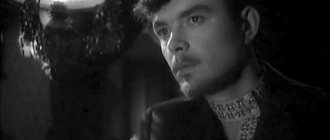Childhood
Georgy Millyar was born on November 7, 1903 in Moscow, in the Russian Empire.
His father, Franz de Milieu, came from a Marseille aristocratic family. He was an engineer by profession and advised Russians on bridge construction issues. Mother, Elizaveta Alekseevna Zhuravleva, was the daughter of an Irkutsk gold miner. The family was rich, had a huge apartment in the center of Moscow and two dachas - in the Moscow region and Gelendzhik.
Franz de Milieu died in 1906 in Yalta. But the childhood of the future actor, who lost his father at the age of three, was still happy.
Georgy Millyar in childhood
Georgy was a home child, studied French and German, music (he especially loved Chaliapin), and read a lot. The aunt, a famous theater actress, took the boy to the theater.
At the age of 7, the boy first showed an inclination towards acting. Having painted his face, he went out in this form to his family and tried to scare them. But instead everyone cheered.
With the advent of Soviet power, this idyll came to an end. Unrest began in Moscow, and the mother took the child to Gelendzhik out of harm’s way. Both changed their French surname to the more down-to-earth “Millary”.
Personal life of celebrities.
The personal life of Georgy Millyar has always caused a lot of rumors and was of interest to his many fans. Several generations of viewers adored his fairy-tale characters and studied with interest the actor’s biography, which had many gaps and omissions. Georgy Frantsevich was born in 1903 into a very wealthy family. His father, the French engineer Franz de Milieu, came to Russia to advise Russian specialists in the field of bridge construction and here he fell in love with the daughter of an Irkutsk gold miner, Elizaveta Zhuravleva, and by marrying her he received not only the love of a beautiful young lady, but also a rich dowry.
In the photo - Georgy Millyar
However, family happiness was short-lived - four years after the wedding, when little George was already growing up, Franz de Milieu died of consumption. But then, with the death of his father, almost nothing changed in Georgy Millyar’s personal life - he continued to live in abundance, relaxing in the summer at his family’s own dachas in the Moscow region or Gelendzhik and receiving a good upbringing and training under the guidance of French governesses. The love of theater was instilled in the future actor by his aunt, a well-known theater actress at that time, thanks to whom he very early became acquainted with the works of Chaliapin, Nezhdanova, and Sobinov. Georgy himself tried to perform in front of his relatives on an improvised stage.
In the photo - the actor in the role of Baba Yaga
Millyar learned about the revolution that had taken place in the country in Gelendzhik, where his mother had taken him in advance, fearing for his life in troubled Moscow. After school, he got a job as a props maker at a local theater. Once he had to play the role of Cinderella instead of a sick actress, and he coped with this task excellently, after which Millyar was trusted with other roles.
In 1924, Georgy Frantsevich returned to Moscow and entered the Junior School at the Moscow Theater of the Revolution, after which he was accepted into the troupe of the same theater. His theatrical career developed very successfully, but the artist was attracted by cinema, and just before the war he left the theater. Millyar began acting first in episodes, and then a fateful meeting took place with the aspiring director Alexander Rowe, and their duet turned out to be more than successful. The actor’s film career did not stand still, but no changes occurred in Georgy Millyar’s personal life - he continued to live with his mother in the room that the state allocated to them in their once own huge Moscow apartment.
In the photo - Georgy Frantsevich and Maria Vasilievna
They say that at the age of thirty he married a young actress who cheated on him, and for this reason their marriage broke up. For the second time, on the advice of his closest friend, Alexander Rowe, he married his communal neighbor, Maria Vasilyevna. Then he was already sixty-five years old, and his wife was sixty. They were a very sweet and touching couple, whose relationship was based on mutual respect.
This celebrity is often searched for:
- Georgy Dronov: personal life I always dreamed of a quiet family life...
- Georgy Taratorkin: personal life A magnificent actor and a wonderful family man...
- Georgy Petrishin: personal life It was his personal life that made Georgy Petrishin a celebrity...
Categories Blog Tags:
Theater
After graduating from school in 1917, Georgy got a job as a prop maker in a local theater. But he did not have to stay in this “dirty job” for long. The actress who was supposed to play Cinderella in a children's play fell ill, and there was no one to replace her. Millyar volunteered to help and played so well that he became one of the leading artists.
Georgy Millyar in his youth
But Georgy still lacked education, so he returned to Moscow and discovered that their dacha near Moscow had been expropriated in favor of the state, and they were left with only one room in their spacious Moscow apartment. The actor lived in this room until 1973.
He entered the acting school at the Revolution Theater (now the Mayakovsky Theater), where he served until 1938. His theater credits include the apothecary in Romeo and Juliet and Count Ludovico in Dog in the Manger. Due to problems with diction, Georgy was not trusted with leading roles, but his passion for acting and innate talent turned even short appearances on stage into an extravaganza.
Made his debut as Cinderella
Georgy Millyar as a child
Gosha was born on November 7, 1903 in the family of the Frenchman Franz de Millieu and Elizaveta Zhuravleva, the daughter of a Russian gold miner. The boy grew up in luxury, surrounded by bonnies and governesses. Even the early death of his father did not affect the family's well-being. After the revolution, Georgy changed his surname to the more democratic Millyar and hid his origin all his life.
Georgy Millyar in his youth
He was interested in art from early childhood. After high school, the young man worked as a prop maker at the Gelendzhik Theater until he urgently needed to replace a sick actress. This is how his stage debut took place in the role of Cinderella. The delicate young man easily transformed into a fairy-tale heroine, and the audience did not notice the substitution. After this, Millyar began to be trusted with small roles in the theater.
Georgy Millyar in his youth
At the age of 20, the young man entered the Junior Theater School, based at the Moscow Theater of Revolution. The teachers were embarrassed by Georgy’s non-standard appearance and obvious problems with diction. But his obvious acting talent allowed him to successfully complete his studies.
Brilliantly performing character roles, the young actor quickly became a favorite of the public. Critics noted his abilities in the field of facial expressions and plasticity, which could be used in cinema. In the early 30s, he played in several episodes, but failed his first major screen test due to severe anxiety.
Tsar Pea, “At the command of the pike”, 1938
When director Alexander Row was selecting actors for his first fairy tale, “At the Command of the Pike,” he remembered the funny, awkward Millyar and invited him to play the role of King Pea. The actor, who was only 35 years old at that time, brilliantly transformed himself into an extravagant, decrepit old man. Thus began a long-term friendship between the director and actor.
Kwak, “Marya the Mistress”, 1959
Millyar played 30 characters in 16 productions by Alexander Rowe: in some films he played 2 or even 3 minor characters.
Film work
Georgy Frantsevich’s dream has always been cinema. Since 1931, he played several episodes in films such as “Puppets” and “Ragged Shoes.”
Georgy Millyar's dream has always been cinema
But his long-term collaboration with director Alexander Rowe made him a real legend. In each of his films, Millyar played 2 or even 3 main roles, and in total he played 30 roles in 16 fairy tales.
Millyar failed his first auditions with Rowe - he was too worried. But the next time he received the role of King Pea in the film fairy tale “By the Pike's Command” (1938).
Georgy Millyar in the film “At the Command of the Pike”
The role of Baba Yaga became the crowning glory for Georgy Frantsevich. She was first played in the film “Vasilisa the Beautiful” (1939). Initially, Faina Ranevskaya auditioned for her, but Millyar convinced the director that a man would do a better job, because not every woman would agree to disfigure herself for the role. In this film, the actor played 2 more roles - an old father and a gray-haired guslar.
Georgy Millyar with director Alexander Rowe on the set
In 1941, Georgy left the theater forever, devoting himself entirely to cinema. Millyar was a keen actor: he himself created sketches for costumes, thought out gestures and facial expressions to the smallest detail. All of his roles required complex makeup, which took 6 hours to apply. One day, make-up artists burned the actor’s face with hydrogen peroxide. But he never complained. “Revealing the secrets of the stars”: Georgy Millyar Koshcheya Millyar played while sick with malaria. The actor contracted the disease during the evacuation of the film crew in Dushanbe. Millyar weighed 48 kilograms and literally turned into a living skeleton, so this time he could play the monster with almost no makeup, especially after he shaved off his hair and eyebrows. The film itself has become a recognized classic not only here, but also abroad. Even Peter Jackson, when he filmed The Lord of the Rings, adopted Roe's epic fairy-tale style. And in the image of Sauron one can easily recognize Koschey, created by Millyar. Georgy Millyar. All evil spirits Periodically, the actor played episodes for other directors. For example, dad Ebenezer Dorset in Gaidai’s first film “Business People” (1962) or the French soldier in “War and Peace” (1967) by Sergei Bondarchuk. But still, Georgy Frantsevich understood: without Rowe, his career would decline.
Georgy Millyar in the film "War and Peace"
And so it happened. After the director's death on December 28, 1973, Millyar gradually began to be forgotten. He played episodes, voiced cartoons, performed at children's events, but could no longer find himself outside of the “fairytale role.” Georgy Frantsevich always dreamed of serious roles; he wanted to play Suvorov and Voltaire. But his dream never came true.
Georgy Frantsevich Millyar
During the New Year holidays, our good old Soviet fairy tales are always shown and everywhere, in every film this unsurpassed actor plays, our amazing Baba Yaga or the Underwater Tsar.. We all really love these wonderful films, where Georgy Millyar is one of the most striking figures. In gratitude for his talent and out of love for his work, I decided to dedicate “my” post to him 
Georgy Millyar was born on November 7, 1903 in Moscow in the family of Franz de Millieu, a French bridge engineer who came to Russia to work, and the daughter of an Irkutsk gold miner, Elizaveta Alekseevna Zhuravleva. The boy's childhood was spent in luxury. But the father died early, in 1906, when his son was not even three years old. Even before the outbreak of the First World War, de Milieu's widow moved from Moscow to Gelendzhik. After 1917, the family was left without relatives and without money; the apartment in Moscow and the house in Gelendzhik were confiscated. The particle “de” was prudently removed from the corrected surname; Georgy Frantsevich did not indicate his knowledge of foreign languages in questionnaires all his life, although he was fluent in French and German.
He worked as a prop maker in the Gelendzhik theater, but, dreaming of the stage, he learned all the roles. The actor's debut took place in the play "Cinderella". The actress who played the title role fell ill, and Millyar replaced her. The unexpected debut was successful, and young Millyar was given another responsibility - to be an ambulance. So in 1020, the acting career of Georgy Frantsevich began with a female role.
In 1924, he was already a well-known provincial actor - he entered the Junior School at the Moscow Theater of the Revolution (now the Mayakovsky Theater).
As Baba Yaga
Millyar took part in many performances that remained forever in the memory of Moscow theatergoers: Duke of Albano
(“Lake Lyul”),
Mokronosov
(“The End of Krivorylsk”),
Pikel
(“Gop-lya, we live”),
pharmacist
(“Romeo and Juliet”),
Attache
(“Calvary”),
Boltikov
(“Inga”),
Imanguzha
("The Ax Poem"),
Mr. Gawker
("Street of Joy"),
Count Ludovico
("The Dog in the Manger").
Theater critics back in the 1920s
The next stage in the creative life of Georgy Millyar is associated with the name of the famous master of children's cinema A.A. Rowe. The director-storyteller found a like-minded person in the actor, and their friendship lasted more than three decades. Their first film was an adaptation of the fairy tale “At the Command of the Pike” about the crafty Emelya the Fool, the capricious Princess Nesmeyan, Pike, who speaks with a human voice, and other miracles. In this film, Millyar played the role of King Pea, and the audience saw a quarrelsome, evil fool, dressed in royal clothes.
Millyar is a pronounced character artist, a master of the grotesque and buffoonery. A unique voice, senilely rattling and squealing, breaking into belly sniffles, was perfectly suited for voicing fairy-tale villains, primarily Baba Yaga, Koshchei the Immortal, the Sea Monster, etc. He practically invented Baba Yaga’s costume and makeup himself - dirty shapeless rags draped over the body and head, dirty gray hair, a large nose with warts, protruding fangs, insanely sparkling eyes.
Millyar's Baba Yaga turned out to be not just scary and ominous, but creepy; many small children were seriously scared when watching the film. Koshchei the Immortal Millyar played using his extremely thin physique and famous voice (regarding the physique, it should be noted that the film was shot during the Great Patriotic War, and the film studio was evacuated to Central Asia, where on the eve of filming the actor suffered from malaria, as a result of which he lost weight during filming only 48 kg).
Filmography
Georgy Millyar played thirty major roles, took part in the dubbing of seventy films, and voiced over a hundred animated films.
1931 - Next to us - general 1933 - Torn shoes - passerby (uncredited) 1938 - At the behest of a pike - Tsar Gorokh 1939 - Vasilisa the Beautiful - guslar, old father, Baba Yaga 1940 - Salavat Yulaev - mine manager 1940 - Siberians - grandfather Yakov 1941 - The Little Humpbacked Horse - wise storyteller, robber, sleeping bag Chikhir 1942 - Schweik is preparing for battle 1943 - The Prince and the Pauper - Jokel 1943 - We are from the Urals - grandfather Tomakurov 1944 - Kashchei the Immortal - Kashchei the Immortal, old man 1947 - A boy from the outskirts 1948 - Postman 1950 - Brave people - German with a province of harmonica 1951 - in the steppe 1952 - May Night, or drowned - clerk 1953 - Breakfast at the leader - Kucher Karp 1954 - Sawn 1954 - Student Sea - Dyachka 1955 - Director - Right 1955 - The fate of the drummer 1955 - The secret of beauty - the chairman of the examination committee 1955 - Self-confident pencil 1955 - White poodle - servant Ivan 1956 - Precious gift - Professor Utyagin 1957 - New attraction 1957 - Star boy - servant (uncredited) 1958 - Youth of our fathers 1958 - How Semaga was caught 1958 - Trappers 1958 - Sampo - the sorcerer 1958 - New adventures of Puss in Boots - jester, witch 1958 - Girl with a guitar - flutist 1959 - The extraordinary journey of Mishka Strekachev - postal worker 1959 - The fate of a man - a drunken German soldier 1959 - Vasily Surikov - mummer 1959 - In our city 1959 - Marya the artist - Kwak 1961 - Evenings on a farm near Dikanka - damn, gossip 1961 - Your own head on your shoulders - watchman 1962 - I bought a dad - a salesman in a pet store 1963 - Business people - dad Dorsett 1963 - Kingdom of Crooked Mirrors - chief master of ceremonies, dowager queen, driver 1963 - Blind Bird - bartender 1963 - Big Wick - steamboat captain 1964 - Morozko - Baba Yaga, robber-sacristan 1964 - An Ordinary Miracle - executioner 1964 - Forty Minutes Before Dawn 1964 — Burnt out at work 1966 — Lost 1966 — Cheerful Rasplyuev days — Omega 1966 — Aladdin’s Magic Lamp — The Wise One 1966 — Captive of the Caucasus, or New Adventures of Shurik — Dominoshnik 1967 — Dubravka — Anton Yurievich, postman 1968 — Fire, water and... copper pipes — Kashchei the Immortal, Baba Yaga, fireman 1968 - Caliph-Stork - sage Selim 1968 - War and Peace - captive Frenchman Morel 1969 - Old House 1969 - Varvara the Beauty, long braid - Tsar Miracle Yudo 1970 - Two Smiles 1970 - Khutorok in steppes 1970 - Step from the roof - leader of the Khaps Gy 1970 - Ballad of Bering and his friends - jester Balakirev 1971 - Hold on to the clouds - Birch 1971 - Property of the Republic - railway worker 1972 - Golden Horns - Baba Yaga, grandfather Markey 1972 - Turn on the northern lights - physics teacher 1975 - Village Duck - Shishok Brownie 1975 - Finist - Clear Falcon - Kastryuk 1976 - While the clock is striking - Minister of War 1976 - Entertainment for old people - grandfather 1978 - Walled up in glass 1978 - New adventures of Captain Vrungel - pharmacy worker 1979 - Autumn bells 1979 - My first friend - the leader of the tramps Dick 1980 - If I were a boss - Lyuba's grandfather 1980 - The story of one slap on the head - Dima Bugaev's great-grandfather 1980 - Flight with an astronaut - an old groom 1980 - Sailors have no questions - passenger 1981 - Andrey and the evil one sorcerer - Tsmok 1981 - Sixth 1983 - Comet - pensioner 1983 - Without much risk - Yalta bus passenger 1983 - Crazy day of engineer Barkasov - neighbor 1984 - Autumn gift from fairies - soldier-guard 1985 - Attention! To all posts... - patient in the hospital 1985 - After the rain on Thursday - vizier of Shah Babadur 1986 - Flight to the land of monsters - general 1988 - Help, brothers! - king 1990 - Murder of a witness - old man from the street 1991 - Five kidnapped monks 1991 - Act, Manya! — Ivan Akimych 1991 — Veniks. Floor brushes - Ariana 1992 - Detonator - Chukchi 1993 - Ka-ka-doo - lawyer
Voiced cartoons
1940 - Ivas 1947 - Little Humpbacked Horse - Tsar 1948 - Tale of a Soldier 1949 - Spring Tale 1950 - Miracle Mill - Tsar 1953 - Forest Concert 1954 - Frog Princess - Baba Yaga 1954 - An arrow flies into a fairy tale - Grandfather Forester-Lesovik 1956 - Million in a bag - millionaire 1957 - In a certain kingdom 1958 - Golden ears 1958 - Beloved beauty 1960 - Royal hares - minister of the king
source: Wikipedia.
Personal life of Georgy Millyar
The actor’s biography never included stormy romances with actresses. Maybe that's why there are still rumors about his homosexuality. In fact, now Millyar would rather be called an asexual.
Rumors about Georgy Millyar's homosexuality still circulate
In 1925 he married a theater actress. Obviously, Millyar had little interest in his wife, because at some stage he had the idea that not everything was all right with him. He checked with the doctor, and he said: “As a man, my friend, you are absolutely fine. But you will never have children.” Soon after this, the wife became pregnant. The actor realized that he was being cheated on and filed for divorce. He lived almost his entire life with his mother.
When Elizaveta Alekseevna died, Rowe found him a wife - 60-year-old Marya Vasilievna, a single woman with two children. After the registry office, the newlyweds went to the shooting of the film “Varvara the Beauty, Long Braid” (1969). Tables were lined along the river, and the film crew honored the newlyweds. The director understood that he needed to marry the actor quickly and decisively - without a woman he would be lost.
Georgy Millyar and his wife Marya Vasilievna
Millyar treated his wife with great tenderness, insisted that she leave work, and called her Manechka. Marya Vasilievna responded by calling him Kosha, going everywhere with him to filming, and being jealous of his partners. The actor had a tense relationship with the Soviet authorities all his life. Millyar did not forget that his family was robbed, and besides, he had to change his last name and hide his noble origin. In his Mosfilm profiles, he wrote: “Simple background, never studied languages.” One can imagine that at such moments the actor felt like a traitor. Maybe that's why he liked to drink on set. But he didn’t like vodka, he preferred cheap port.
Georgy Millyar was a modest and trusting person
Millyar was not involved in party work and did not attend meetings. He was friends not with the bosses, but with the studio workers: lighting technicians, make-up artists, costume designers. The Soviet government also did not particularly honor Millyar. They didn’t give him cars or invite him to celebrations. But she didn’t see him as a threat either, and therefore didn’t pursue him. But ordinary people adored the actor.
Only in 1973, he and his wife were given a two-room apartment on the 18th floor, far from the metro. Millyar received the title of Honored Artist in 1988, on his 85th birthday.
Georgy Millyar - legendary Soviet actor
For the same anniversary, he was invited to perform for children in the Rossiya concert hall. Millyar approached this part with full responsibility. He knew that there were 850 seats in the hall, and he drew 850 pictures of Baba Yaga for each young spectator. But on the appointed date they never sent a car for him, no one even called and said that the performance was cancelled. Some of the drawings were distributed among the actor’s friends, and some ended up in museum archives.
Power relations and care
Despite numerous works in cinema and theater, Georgy Millyar (biography, photos discussed in the article) never made a significant fortune. For some reason, the Soviet government was in no hurry to shower the people's favorite with benefits. He received his first separate apartment only at the age of 80. Maria Vasilievna more than once persuaded her husband to seek help or support from government agencies, but natural modesty prevented him from doing this.
Georgy was awarded the title of People's Artist of the Soviet Union only at the age of 85. At the same time, not a single creative evening or benefit performance of the actor was performed during his lifetime. He continued to play, work and enjoy art without asking for anything in return. At the same time, whenever possible, he himself tried to give gifts or arrange surprises for the audience.
The master was especially warm towards children who came to performances and films. In preparation for one of the concerts, Millyar used his personal money to buy sketchbooks, which he signed for each spectator in the hall. And after the concert was canceled for unknown reasons, the artist gave all the souvenirs to the boys and girls living in his area.
Even the passing of everyone’s favorite performer of fairy-tale roles happened unnoticed by the general public. Having lived a colorful and eventful life, he passed away a few months before his 90th birthday in June 1993. Beloved Maria outlived her husband by six years and was buried next to him at the Troekurovsky cemetery.
Death
Georgy Frantsevich died on June 4, 1993 in Moscow from pneumonia. He passed away peacefully, in his sleep, just short of his 90th birthday.
Georgy Millyar in the last years of his life
Being a believer, on the eve of his death he called the holy father to his house to confess. The actor was buried at the Troekurovsky cemetery.
Georgy Millyar was buried at Troekurovskoye Cemetery
When Marya Vasilievna passed away in 1999, many of Millyar’s personal belongings were thrown into a landfill. Only a small part was transferred to the Cinema Museum.
10 years after Millyar’s death, the documentary film “Georgy Millyar – both in a fairy tale and in life” was released.
“Georgy Millyar – both in a fairy tale and in life”
First labor feats
Immediately after graduating from school, Georgy went to work as a prop maker at a local theater. In love with all productions and having grown up watching the performances of the great geniuses of the early last century, he knew all the monologues of the repertoire. Watching professional actors play from behind the scenes, he passionately dreamed of one day being in their place.
And only thanks to an accident, Millyar managed to do this. Having replaced a sick actress in a production of the fairy tale “Cinderella,” the young man became so sick of the theater that he decided to go learn the craft. Arriving in Moscow for the first time after his forced departure, the young man easily entered the Mayakovsky Theater.
But studying was not easy for the strange student, whom the teachers could not fully understand. True masters of their craft saw talent in the ambitious young man, but his atypical appearance and strange diction put an end to his possible acting career.











